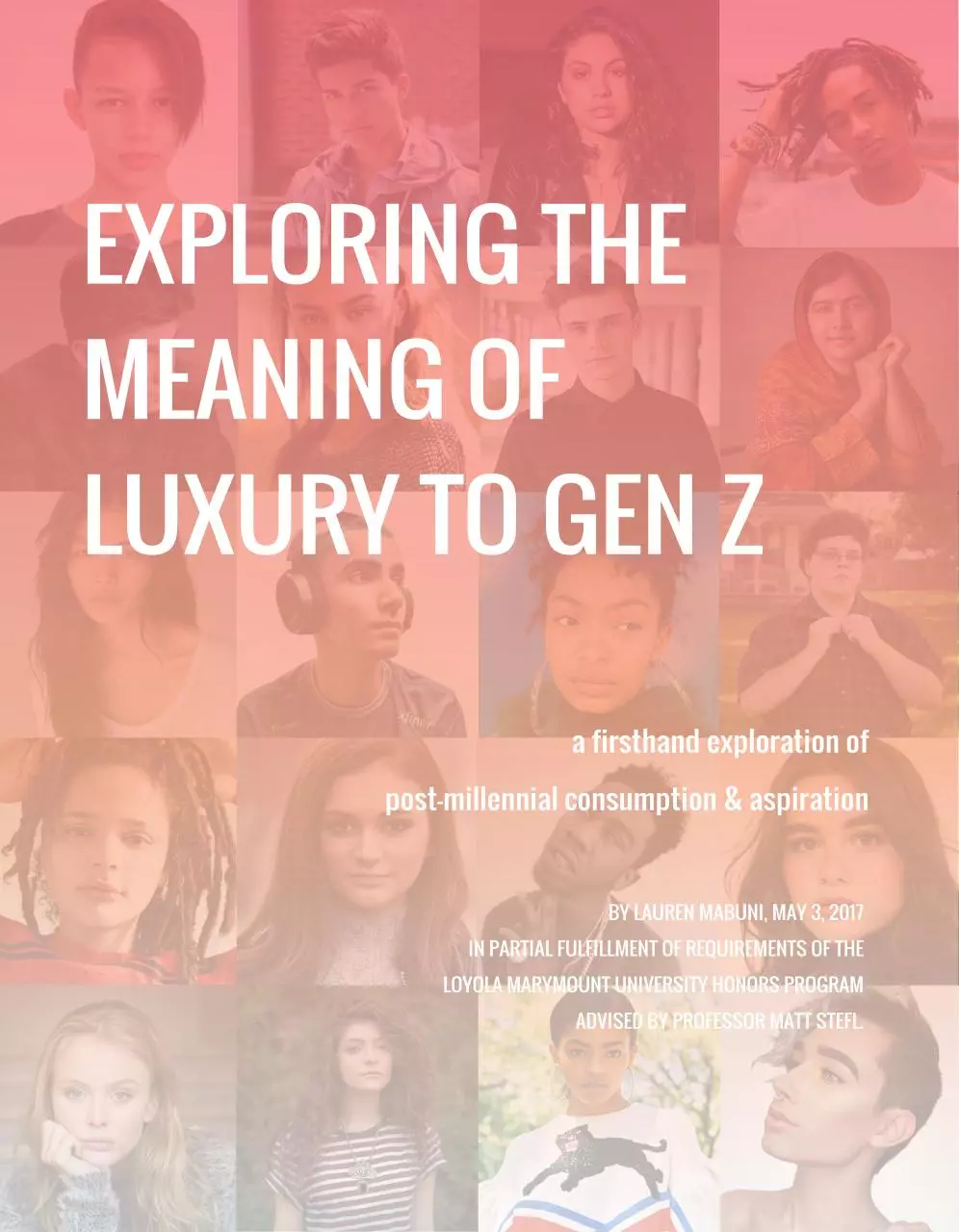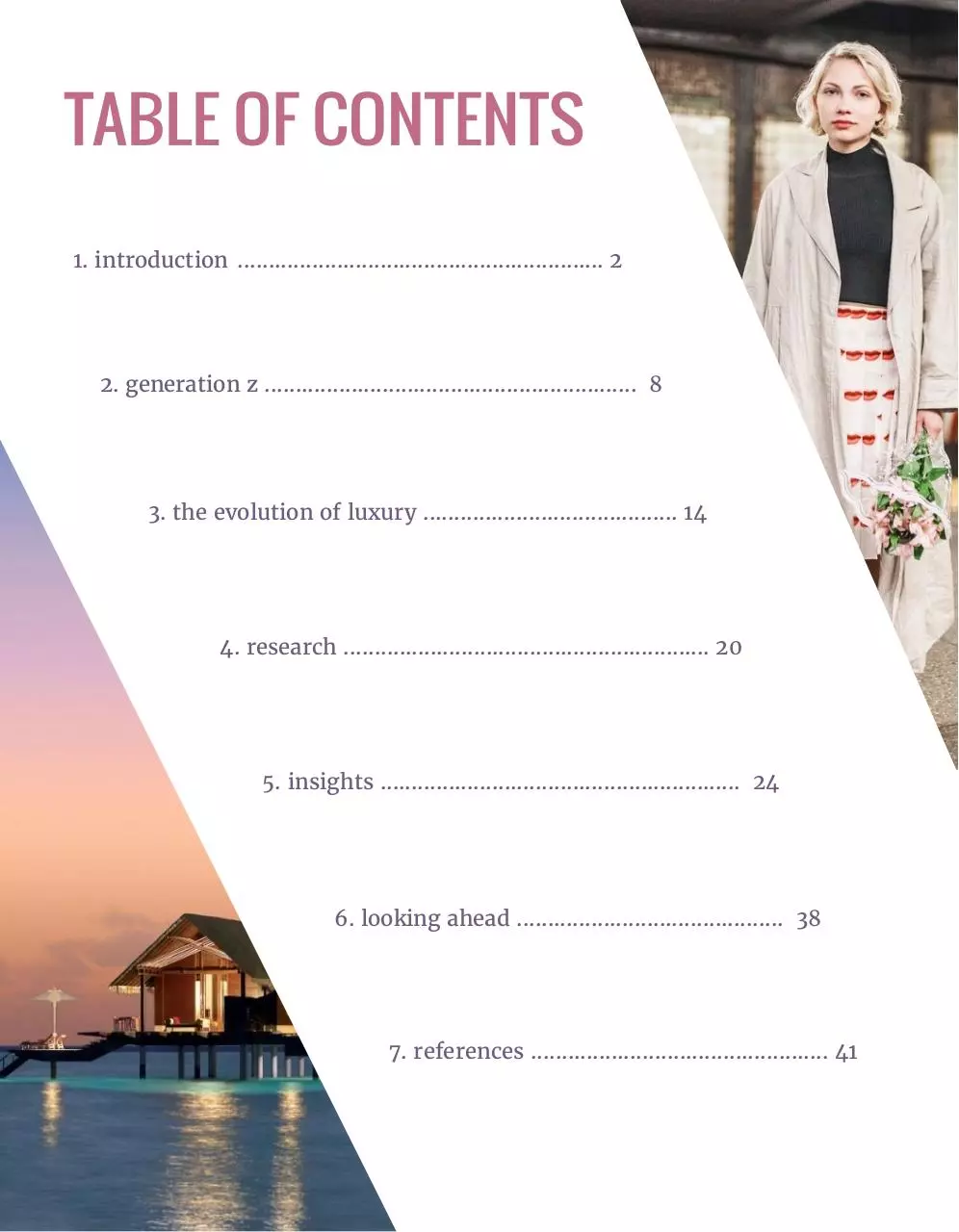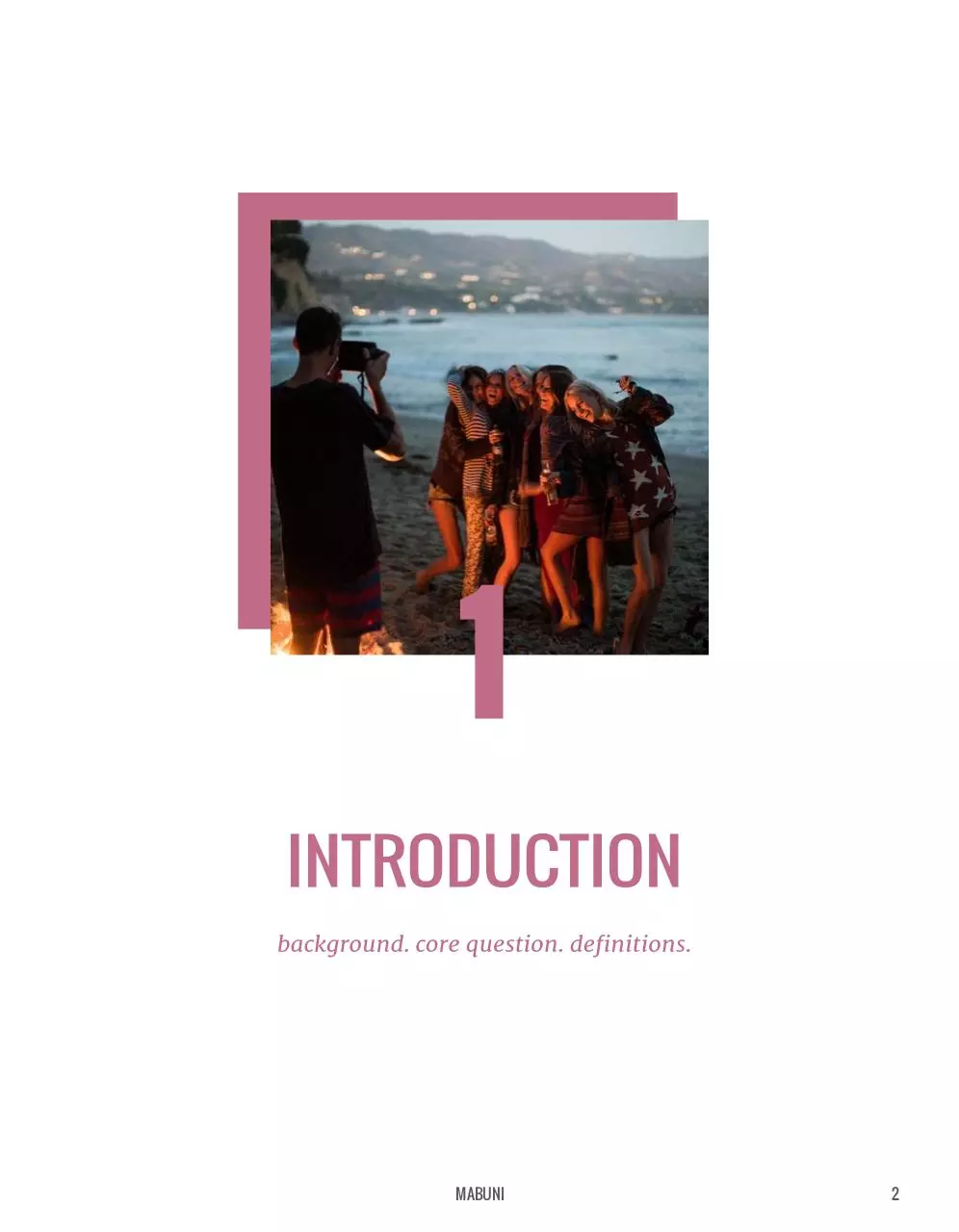Exploring the Meaning of Luxury to Gen Z Mabuni May 2017 (PDF)
File information
Author: Lauren Mabuni
This PDF 1.5 document has been generated by Microsoft® Publisher 2016, and has been sent on pdf-archive.com on 24/05/2017 at 18:43, from IP address 23.243.x.x.
The current document download page has been viewed 527 times.
File size: 19.89 MB (48 pages).
Privacy: public file





File preview
MABUNI
1
1. introduction ........................................................... 2
2. generation z ............................................................ 8
3. the evolution of luxury ......................................... 14
4. research ........................................................... 20
5. insights .......................................................... 24
6. looking ahead ........................................... 38
7. references ................................................ 41
MABUNI
2
1. INTRODUCTION
MILLENNIALS ARE THE
MOST RESEARCHED AND
MARKETED TO GENERATION IN HISTORY.
But for forward-thinking brands and marketers, what—or who—is next?
In an age when marketers are spending five times more to reach Millennials than all other demographics combined (Swant 2015),
Generation Z, Millennials’ entrepreneurial and diverse younger siblings born from the mid-1990’s to 2010’s, are quietly becoming
one of the of the most powerful consumer segments in the U.S. and around the world. Despite the fact that most brands are still
clamoring for their piece of the Millennial pie, Generation Z is already influencing a staggering $829 billion in household spending
in the U.S. alone (IBM 2017). Diverse, ambitious and predicted to account for 40% of the population in key current and emerging
luxury markets (Europe, the U.S. and BRIC countries) by 2020, they are heralding a new age of consumption.
At the same time, the world of luxury goods and services is
rapidly evolving. Conventions of affluence, status and
exclusivity have been overturned by seismic shifts in the
category and in culture. Objects of status and desire are being
redefined as aspiration moves away from the ownership of
goods toward access to fulfilling and transformative
experiences.
Aware of these cultural and categorical trends, I became
curious about both the future of luxury and Generation Z as a
consumer segment. As I began to explore the growing body of
literature on Gen Z for potential topics of exploration for my
thesis and was simultaneously apprenticing with a brand
agency that specializes in premium and luxury brands, I
discovered a little explored territory at the intersection of
these two segments. Although a wealth of information exists
on the perceptions and expressions of luxury today among
Baby Boomer, Gen X and Millennial consumers, very little
research has been conducted on the unique meaning of luxury
consumption to the emerging Generation Z cohort. Thus, the
Former spokesmodel for Chanel Eyewear, Lilly-Rose Depp (b. 1999) is just one of a new wave
of teen celebrities influencing the world of luxury and high fashion (George-Parkin 2016).
crux of my study became:
“What does luxury mean to Generation Z?”
What objects and experiences do they associate with indulgence? What do they consider to be worth a premium?
How is status earned, displayed and interpreted among them?
After conducting a comprehensive audit of existing literature, I was still left many questions. I didn’t want to limit my inquiry and
analysis to the conventional avenues of checkbox surveys yielding one-dimensional data—I wanted to explore the underlying beliefs
and value systems that drove consumption attitudes and behaviors. As a member of Generation Z (and a college student without a
research budget), I decided to talk to my peers about luxury and aspiration in their language, simply asking them what they aspired
to—what they aspired to own, what they aspired to do and what they aspired to be. While my limited sample was certainly not
representative of the generation as a whole, their insightful responses, when triangulated with quantitative secondary sources and
qualitative cultural context, help to paint a richer picture of the “why’s” behind this next generation of consumers. And while every
generation likes to believe that it is unique, the more that I read, the more I am convinced that our generation’s complex and
nuanced “why’s” will have a particularly profound impact on luxury consumption in the years to come.
ACKNOWLEDGEMENTS
As a student in the M-School Institute of Marketing at Loyola Marymount University’s College of
Business Administration, I am fortunate to be in a program of study that has exposed me to real
world branding and advertising projects and industry mentors through close relationships with
leading agencies. As an apprentice with the strategic planning group at Team One, Publicis
Groupe’s luxury brand agency, I am also lucky to be surrounded by experts in luxury brand
marketing. As a result, there are many advertising industry mentors who have encouraged and
inspired me to explore this topic, including M-School codirectors and instructors, Professor Matt
Stefl and Dr. Andrew Rohm and my apprenticeship mentor at Team One and the agency’s Chief
Strategy Officer, Mark Miller.
As my faculty advisor, Professor Matt Stefl played an integral role in bringing this project to life. A
15-year veteran of the advertising industry, Matt most recently served as EVP and director of
strategic planning at Dailey & Associates. From helping me hone in on my thesis topic to directing
me to relevant industry reports and advising on research design and synthesis, he was invaluable throughout the process.
Cultural anthropologist, Steven Garcia who was coincidentally both a guest lecturer at the M-School and now works at Team One
also helped me throughout the project. I consulted Steven periodically over the course of the project, even shadowing him on two
ethnographic interviews for his own thesis for his M.S. in applied anthropology at the University of North Texas. Steven provided
very practical insight into the methodology, design and analysis of the ethnographic approach in marketing and directed me to
valuable resources on cultural anthropology in the private sector. Similarly, senior strategic planner, Teresa Cruz who spearheads
Team One’s Global Affluent Leadership Tribe research and thought leadership platform, contributed her expertise on trends in
luxury consumption and brand marketing to help me formulate my review of literature and interview guide questionnaire.
WHY GENERATIONAL SEGMENTATION?
Widely popularized by generational researchers William Straus and Neil Howe
in the 1990’s, generational segmentation has been utilized by social scientists,
policymakers, and business strategists for decades (New Strategist Press 2013).
It is predicated on the assumption that a birth year-defined cohort’s shared
events and experiences during the formative years of childhood and
adolescence cause the group to develop “similar preferences, ways of thinking
and patterns of behavior” (Klaer 2016: 2). Thus “a group of people bound by
the kinship created through shared events that changed the society in which
they grew up,” coalesce over time to form a generation (Merriman 2015: 3).
The events and experiences that define a generation may be political,
economic, social, technological or environmental in nature. For example,
national or international catastrophes such as war, major natural disaster or
financial recession will often shape a generation’s attitudes and behaviors.
Conversely, advancements in technology and society such as increased access
to information, communication and education also play a crucial role in
molding generations (New Strategist Press 2013). When over-relied upon,
generational segmentation runs the risk of reductionist oversimplification and
generalization. However, when layered on other methods of marketing
Jewelry designer, Choichung Leung and her daughter, Gen Z
influencer and model, Sahara Lin (b. 1997) pose for Refinery29.
analysis, generational research provides valuable insight into high level trends,
sentiments and cultural shifts.
MABUNI
4
DEFINING GENERATION Z
Although like all generational segments there
are no universally accepted birth years that
clearly define Generation Z, leading business
consulting and market research firms
including IBM (2017: 1), KPMG (2011),
Euromonitor (2017: 12), Marketo (Jones 2014),
Vision Critical (2016), and one of the
pioneering agencies of Gen Z research, Sparks
& Honey (2014), commonly define the cohort
as beginning in 1995 and spanning until the
mid 2010’s or today. Based on this definition,
many of Generation Z’s oldest members
(myself included) are graduating from fouryear colleges and universities and entering the
workforce full-time this year. This research
focuses on members of the cohort born
between 1995 and 1999, currently ages 18 to
22, to provide a glimpse into a more
homogenous post high school early adulthood
life stage.
In addition to the work of previously
mentioned industry thought leaders, this
paper draws upon several secondary research
sources that differ marginally in their
definitions of the Generation Z cohort (no
more than two years). Other monikers
referring to the demographic born in the mid
to late 1990’s include: Gen We beginning 1996
(Iconoculture 2017); iGeneration beginning in
1997 (Schneider 2015); Pivotals beginning in
1997 (Swartz 2017: 6); and Centennials
beginning in 1997 (Inskip 2016). These terms
are often used interchangeably.
Top to bottom: Gen Z influencers: 18-year-old engineer and
entrepreneur George Matus; 18-year-old rapper Kodie Shane; 18year-old professional gamer; Sumail Hassan; and 20-year-old
model Barbie Ferreira (Matus, Hassan and Ferreira were featured in
TIME Magazine’s list of “Most Influential Teens” in 2016).
DEFINING LUXURY
Luxury has always been complex and multifaceted, taking
on a myriad of diverse meanings to different individuals
whether associated with status, wealth, extravagance,
indulgence, reward, escape, comfort or mobility. Perhaps
most commonly, luxury is conflated with wealth that
affords the ownership of premium goods and services. As
a result, luxury has traditionally been thought of as a
category of goods and services restricted to an elite few
who can afford them rather than accessible to many.
However, today’s
luxury is far more
diverse, multifaceted
and complex than ever
before.
Seismic trends in both business and
culture over the past few decades have
broadened access to goods and services
that were traditionally considered to be
luxury (Silverstein 2003). Thus, today’s
luxury is more difficult to define today
than ever before. The primary research
component of this study examines luxury
broadly in the context of indulgence,
leisure, status and aspiration, seeking to
explore attitudes that may develop over
time rather than exclusively viewing
luxury through the lens of a price tag or
income bracket.
MABUNI
6
DEFINING THE ETHNOGRAPHIC APPROACH
Ethnography, the study of culture, originates in cultural anthropology but has gained
traction in the private sector over the past few decades. Ethnographic user
experience researcher and author of Practical Ethnography: A Guide to Doing
Ethnographic Research in the Private Sector, Dr. Sam Ladner attributes the
popularity of the approach in the business world to two factors: first,
because it is “conducted in context” it provided new insights into
use cases, preferences and other valuable observational points
that may be missed by traditional market research. Second it
takes the rare approach of defining and seeking to
understand the world from its participants’ point of
view (Ladner 2014: 17). Although I have designed
and analyzed my research from the
ethnographic approach, my project is not
representative of a true ethnography
which often involves months and
even years of in situ
research.
“THE
ETHNOGRAPHIC
METHOD IS STEEPED
A shop-along Abbott Kinney
Boulevard in Venice with research
participants, Edan & Esther, (b. 1995)
LMU undergraduate students from
Manhattan Beach and Guangzhou.
IN THE PATIENT APPROACH
TO DOCUMENTING SOCIAL LIFE
AND MAKING INTERPRETATIONS
ABOUT ITS MEANING.” (LADNER 2014: 16)
MABUNI
8
Download Exploring the Meaning of Luxury to Gen Z - Mabuni May 2017
Exploring the Meaning of Luxury to Gen Z - Mabuni May 2017.pdf (PDF, 19.89 MB)
Download PDF
Share this file on social networks
Link to this page
Permanent link
Use the permanent link to the download page to share your document on Facebook, Twitter, LinkedIn, or directly with a contact by e-Mail, Messenger, Whatsapp, Line..
Short link
Use the short link to share your document on Twitter or by text message (SMS)
HTML Code
Copy the following HTML code to share your document on a Website or Blog
QR Code to this page

This file has been shared publicly by a user of PDF Archive.
Document ID: 0000601676.